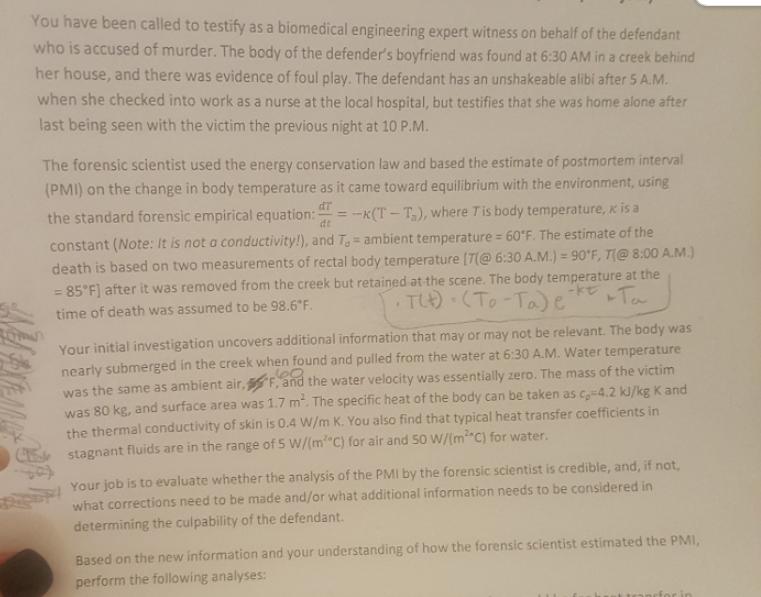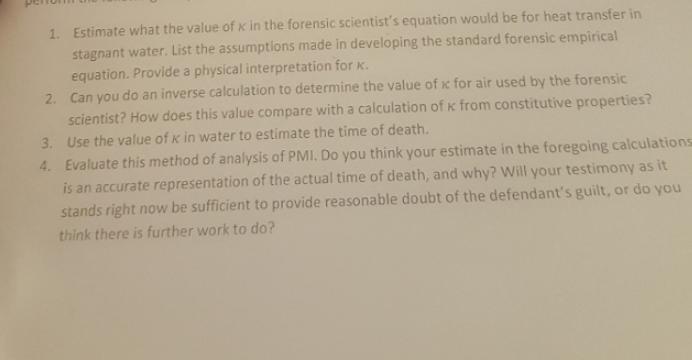Answered step by step
Verified Expert Solution
Question
1 Approved Answer
You have been called to testify as a biomedical engineering expert witness on behalf of the defendant who is accused of murder. The body


You have been called to testify as a biomedical engineering expert witness on behalf of the defendant who is accused of murder. The body of the defender's boyfriend was found at 6:30 AM in a creek behind her house, and there was evidence of foul play. The defendant has an unshakeable alibi after 5 A.M. when she checked into work as a nurse at the local hospital, but testifies that she was home alone after last being seen with the victim the previous night at 10 P.M. dr The forensic scientist used the energy conservation law and based the estimate of postmortem interval (PMI) on the change in body temperature as it came toward equilibrium with the environment, using the standard forensic empirical equation:- -K(T-T), where Tis body temperature, x is a constant (Note: It is not a conductivity!), and T.= ambient temperature = 60F. The estimate of the death is based on two measurements of rectal body temperature (71@ 6:30 A.M.) = 90F, T(@ 8:00 A.M.) = 85F] after it was removed from the creek but retained at the scene. The body temperature at the T() (To-Ta) e time of death was assumed to be 98.6F. -kt Your initial investigation uncovers additional information that may or may not be relevant. The body was nearly submerged in the creek when found and pulled from the water at 6:30 A.M. Water temperature was the same as ambient air, and the water velocity was essentially zero. The mass of the victim was 80 kg, and surface area was 1.7 m. The specific heat of the body can be taken as c=4.2 kJ/kg K and the thermal conductivity of skin is 0.4 W/m K. You also find that typical heat transfer coefficients in Cstagnant fluids are in the range of 5 W/(m**C) for air and 50 W/(m"C) for water. Your job is to evaluate whether the analysis of the PMI by the forensic scientist is credible, and, if not, what corrections need to be made and/or what additional information needs to be considered in determining the culpability of the defendant. Based on the new information and your understanding of how the forensic scientist estimated the PMI, perform the following analyses: 1. Estimate what the value of x in the forensic scientist's equation would be for heat transfer in stagnant water. List the assumptions made in developing the standard forensic empirical equation. Provide a physical interpretation for k. 2. Can you do an inverse calculation to determine the value of x for air used by the forensic scientist? How does this value compare with a calculation of k from constitutive properties? 3. Use the value of k in water to estimate the time of death. 4. Evaluate this method of analysis of PMI. Do you think your estimate in the foregoing calculations is an accurate representation of the actual time of death, and why? Will your testimony as it stands right now be sufficient to provide reasonable doubt of the defendant's guilt, or do you think there is further work to do?
Step by Step Solution
There are 3 Steps involved in it
Step: 1
Analysis of Postmortem Interval Estimation 1 Heat transfer in stagnant water K in the equation represents the rate constant for heat transfer between ...
Get Instant Access to Expert-Tailored Solutions
See step-by-step solutions with expert insights and AI powered tools for academic success
Step: 2

Step: 3

Ace Your Homework with AI
Get the answers you need in no time with our AI-driven, step-by-step assistance
Get Started


